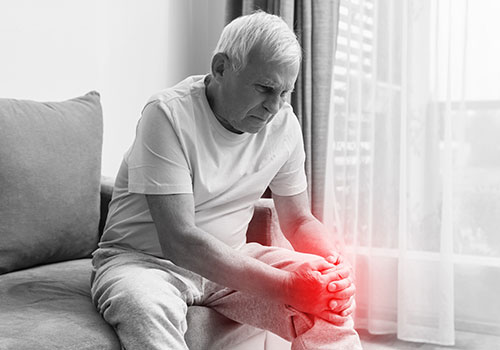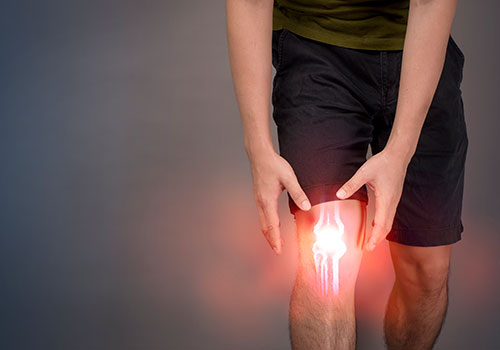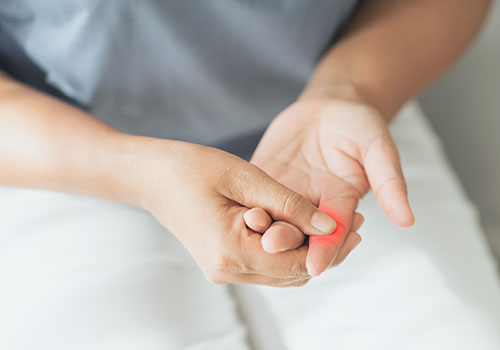PAIN MANAGEMENT
JOINT PAIN
Joint pain is a common complaint that can affect people of all ages. It can range from mild discomfort to severe pain and can be caused by various factors. Here are some common causes of joint pain and tips for managing it:

- Arthritis: Arthritis is a common cause of joint pain. There are different types of arthritis, including osteoarthritis (wear-and-tear of joint cartilage) and rheumatoid arthritis (an autoimmune disease). Treatment for arthritis may include medication, physical therapy, and lifestyle changes.
- Injuries: Joint pain can result from injuries, such as sprains, strains, or fractures. Rest, ice, compression, and elevation (the RICE method) can help alleviate pain and promote healing.
- Overuse: Repetitive movements or overuse of a joint, especially in activities or sports, can lead to joint pain. Rest and proper technique can help prevent and manage overuse injuries.
- Inflammation: Inflammation in the joints, often due to conditions like bursitis or tendinitis, can cause pain and swelling. Treatment may include rest, anti-inflammatory medications, and physical therapy.
BACK PAIN
Back pain is a prevalent and often debilitating condition that can affect people of all ages. It can have various causes and may range from mild discomfort to severe, chronic pain. Here are some common causes of back pain and tips for managing it:
- Muscle Strain: Overexertion, lifting heavy objects improperly, or sudden movements can lead to muscle strain in the back. Rest and gentle stretching can help alleviate strain-related pain.
- Poor Posture: Maintaining poor posture while sitting, standing, or working at a computer for extended periods can strain the back muscles and lead to pain. Ergonomic adjustments and posture correction exercises can help.
- Herniated Disc: A herniated or slipped disc occurs when the soft inner part of a spinal disc pushes through a crack in the tougher outer layer, putting pressure on nearby nerves. Treatment may include rest, physical therapy, or surgery in severe cases.
- Arthritis: Osteoarthritis and other forms of arthritis can affect the spine and cause pain. Management typically involves pain medication, physical therapy, and lifestyle modifications.
- Sciatica: Sciatica occurs when the sciatic nerve, which runs from the lower back down the leg, is compressed or irritated. Treatment may involve physical therapy, medication, or, in some cases, surgery.
- Spinal Stenosis: Spinal stenosis is the narrowing of the spinal canal, which can put pressure on the spinal cord and nerves, leading to back pain. Treatment options include medication, physical therapy, and surgery in severe cases.
- Scoliosis: Scoliosis is an abnormal curvature of the spine that can cause back pain, especially as it progresses. Management depends on the severity of the curvature and may include bracing or surgery.
- Injuries: Trauma from accidents or falls can result in back pain. Immediate medical attention is often necessary to assess and treat injuries.
- Lifestyle Factors: Being overweight, lack of exercise, and smoking can contribute to back pain. Lifestyle changes like weight loss, regular exercise, and quitting smoking can help.
- Psychological Factors: Stress, anxiety, and depression can exacerbate back pain. Managing mental health through therapy, relaxation techniques, and stress reduction strategies can be beneficial.
KNEE PAIN
Ayurveda offers various treatments and remedies for knee pain. It focuses on balancing the body’s energies, or doshas (Vata, Pitta, and Kapha), to promote overall health and alleviate specific health issues like knee pain. Keep in mind that it’s important to consult with a qualified Ayurvedic practitioner before starting any treatment, as the specific approach may vary based on your individual constitution and the underlying cause of your knee pain.
Ayurveda emphasizes the balance of doshas. If your knee pain is due to an imbalance in the Vata dosha, your Ayurvedic practitioner may recommend dietary and lifestyle changes to pacify Vata. This could include warm and nourishing foods, regular oil massages, and a calming daily routine.
- Herbal Remedies:
- Ashwagandha: This adaptogenic herb can help reduce inflammation and pain in the joints.
- Guggul: It has anti-inflammatory properties and may aid in relieving knee pain.
- Turmeric: Known for its anti-inflammatory properties, turmeric can be added to your diet or taken as a supplement.
- Boswellia: This resin extract may help reduce pain and inflammation in the knee joints.
- External Therapies:
-
- Ayurvedic Oil Massage (Abhyanga): Regularly massaging the affected knee with warm sesame oil or Mahanarayan oil can provide relief from knee pain.
- Herbal Compress (Poultice): Applying a warm poultice of Ayurvedic herbs like Dashamula can help reduce inflammation and pain.

ARTHRITIS
Ayurveda offers various treatments and approaches for managing arthritis, which is a condition characterized by inflammation and pain in the joints. Keep in mind that Ayurvedic treatments should be personalized based on the type of arthritis you have and your individual constitution (dosha). Consult with a qualified Ayurvedic practitioner to develop a suitable treatment plan. Here are some common Ayurvedic remedies and approaches for managing arthritis:
- Balancing Doshas: Ayurveda focuses on balancing the doshas, especially Vata, which is often associated with arthritis. The treatment approach will depend on your dosha constitution.
- Herbal Remedies:
- Guggul: This resin extract has anti-inflammatory properties and is commonly used to reduce inflammation and pain in arthritis.
- Ashwagandha: An adaptogenic herb that can help reduce inflammation and improve joint health.
- Turmeric: Known for its potent anti-inflammatory properties, turmeric can be taken as a supplement or added to your diet.
- Boswellia: Another anti-inflammatory herb that can alleviate joint pain.
- Ayurvedic Oil Massage (Abhyanga): Regularly massaging the affected joints with warm sesame oil or specific herbal oils can help reduce pain and inflammation.
RHEUMATOID ARTHRITIS

Rheumatoid arthritis (RA) is a chronic autoimmune disease that causes joint inflammation and pain. While Ayurveda can provide relief from the symptoms of RA, it’s important to note that it may not offer a cure for the condition. Ayurvedic treatments for rheumatoid arthritis focus on reducing inflammation, managing pain, and improving overall well-being.
Ayurveda considers the balance of doshas (Vata, Pitta, and Kapha) in managing health conditions. In RA, an aggravated Vata dosha is often associated with joint pain and inflammation. We will work to balance your doshas through dietary and lifestyle recommendations.
Ayurvedic treatments for RA should be integrated into your overall healthcare plan, and you should continue to work with us in autoimmune diseases to ensure comprehensive care and monitoring of your condition.
CERVICAL SPONDYLOSIS
Cervical spondylosis, also known as cervical osteoarthritis or neck arthritis, is a degenerative condition that affects the cervical spine (the neck region). It typically occurs as people age and involves the wear and tear of the spinal discs and vertebrae in the neck. While cervical spondylosis is a common condition, it can lead to pain and discomfort in the neck, shoulders, and arms. Here are some aspects of cervical spondylosis, including its causes, symptoms, and treatment options:
Causes:
- Aging: One of the primary causes of cervical spondylosis is the natural aging process. As you get older, the discs between your vertebrae can lose moisture and become less flexible, leading to degeneration.
- Wear and Tear: Repetitive stress on the neck and spine due to poor posture, heavy lifting, or other activities can accelerate the degenerative process.
- Herniated Discs: Discs between the vertebrae can herniate or bulge, putting pressure on spinal nerves and causing symptoms.
- Bone Spurs: Over time, the body may develop bone spurs (osteophytes) on the vertebrae, which can compress nerves.
STIFF SHOULDER
A stiff shoulder can be caused by various factors, including muscle tension, injury, or underlying medical conditions. Here are some common causes and tips for managing a stiff shoulder:
Common Causes of a Stiff Shoulder:
- Muscle Tension and Stress: Stress and tension can lead to muscle stiffness in the shoulder and neck area.
- Overuse or Strain: Activities that involve repetitive or strenuous shoulder movements, such as lifting heavy objects or certain sports, can lead to muscle strain and stiffness.
- Frozen Shoulder (Adhesive Capsulitis): This is a condition characterized by the gradual loss of shoulder joint mobility and is often associated with pain and stiffness.
- Rotator Cuff Injury: Injuries to the rotator cuff muscles or tendons can result in shoulder pain and stiffness.
SINUSITIS
Sinusitis, also known as rhinosinusitis, is a common condition characterized by inflammation or infection of the paranasal sinuses. These are the hollow spaces located around the nose and behind the eyes. Sinusitis can be acute (short-term) or chronic (lasting longer than 12 weeks) and may result from various causes, including viral, bacterial, or fungal infections, allergies, or anatomical issues. Here’s an overview of sinusitis, its symptoms, causes, and treatment options:
Symptoms of Sinusitis:
The symptoms of sinusitis can vary in intensity and duration but often include:
- Nasal Congestion
- Facial Pain or Pressure
- Headache
- Runny or Stuffy Nose
MIGRAIN
Migraine is a common neurological disorder characterized by recurring moderate to severe headaches, often accompanied by other symptoms such as nausea, vomiting, and sensitivity to light and sound. Migraines can be extremely debilitating and disruptive to daily life.
Causes of Migraines:
Some common triggers and contributing factors include:
- Genetics
- Hormonal Changes
- Triggers
- Stress
- Sleep Patterns
- Physical Factors

